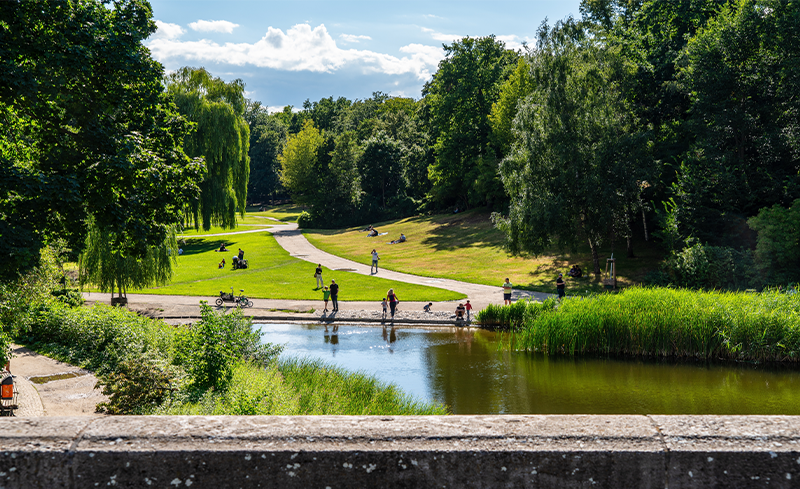Can Trees Heal You?

Sonja Sudimac grew up immersed in nature. Belgrade, Serbia, where she is from, is packed with lush forested parks and bordered by the mighty Danube and Sava Rivers. But when Sudimac traveled in Europe and the United States as an adult, she realized many cities lacked the trees and waters of her childhood. Now an environmental neuroscience researcher at the Max Planck Institute for Human Development in Berlin, Sudimac was curious how exposure to nature shapes the brain.
Over the past decade, scientists have published a substantive body of research that suggests nature enhances working memory, regulates our emotions, increases self-reliance, and fosters creativity. Yet most of these studies rely on participants’ subjective reports about their feelings after exposure. Sudimac and fellow researchers Simone Kühn and Vera Scale wanted to see if there was a causal connection between nature and well-being. “You can’t fake the results you get from the brain,” says Sudimac.
In 2022, the trio of researchers published the results of an experiment they ran in Berlin, looking at how a walk alone in the woods versus a stroll in the city affects activity in the amygdala. The part of the brain linked to fear, anxiety, and other emotions, the amygdala is typically monitored with magnetic resonance imaging (MRI) machines. A previous study had shown that the amygdala is more activated during a stressful task among city residents than among country residents, but no study had examined the brain before and after a person took a walk in a natural versus urban environment.
Nature could help “restore individuals from stress.”
The researchers first presented 63 study participants with fearful facial images in the lab while performing MRI scans of their brains to measure their baseline amygdala responses. Then the participants were split into two groups and sent on solitary hour-long walks. One group strolled down Schloßstraße (Castle Street), through a bustling urban area. The other was sent into the sprawling Grünewald Forest at Berlin’s western edge, where curving paths branch into miles of woods. Participants were instructed to leave their phones behind, to walk alone, and to avoid speaking with anyone. Afterward, the participants all came straight back to the lab, where the researchers gave them a second stress image test while they underwent MRI scans. They later filled out a questionnaire about their experiences.
When Sudimac and her peers compared the MRI scans, they saw that participants’ who had walked in Grünewald had less active amygdalas than they had in the pre-test. For those who took the walk down a city street, amygdala activity remained the same. The walkers’ self-reported feelings about their experiences correlated with the MRI results—those who strolled among the pine and beech trees said they enjoyed the walk more than those who passed shops and restaurants. So those who walked down a busy city street may have accrued physical fitness benefits, but not measurable mental ones. The nature group also reported feeling more restored. The Max Plank researchers concluded that nature could help “restore individuals from stress.”
Sudimac and her peers point out that these findings line up with psychology-based Stress Recovery Theory, which was developed in the early 1990s. The theory stipulates that nature increases our positive emotions while decreasing negative emotions like fear.
URBAN WILDERNESS: Rudolph Wilde Park in Berlin features a lake, hiking paths, open green space—and a landmark subway station. Berlin public transport connects to many forests and lakes within the city. In some other large cities, access to nature can depend on having a car. Photo by Mo Photography Berlin / Shutterstock.As people continue to migrate to cities—almost 70 percent of the world’s population will live in an urban area by 2050—Sudimac hopes that environmental neuroscience can help shape urban planning, encouraging the incorporation of easily accessible wild spaces for city residents. Berlin is a city of green spaces, with public transport that connects to forests and lakes, but in other cities, access to nature can depend on having a higher income and a car.
Sudimac tells me a colleague of hers is looking into how natural versus human-made noise impacts humans, and has found that listening to birdsong decreases paranoia and anxiety in healthy participants. Studies have also documented that living in cities is correlated with higher rates of mental illness than living in rural areas, and Sudimac wonders if incorporating nature into urban planning could help mitigate health risks. Doctors in New Zealand, the United Kingdom, and other countries have experimented with issuing “green prescriptions,” instructing patients to spend more time outdoors, with positive health benefits reported for mental and cardiovascular measures. If, in the future, more evidence accumulates showing that nature has a positive impact on our neurotransmitters, it could even be prescribed for people at risk of developing mental or physical health conditions.
When I met Sudimac for coffee in March, she was full of questions for further research. Were there woods that could induce fear instead of restoring calm? How important was it to see clouds float across the sky? Would people from different cultural backgrounds have different responses to her walk in the woods experiment? She was immersed in conducting new research looking at how different types of nature impact the brain, such as glimpsing a blue lake or crossing an open space. “We have to be aware as a society that access to nature affects health,” said Sudimac. “Nature shouldn’t be a privilege, it should be accessible to everyone.”
Lead image: icemanphotos / Shutterstock
The post Can Trees Heal You? appeared first on Nautilus.


